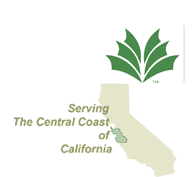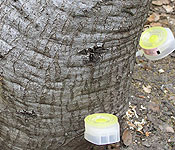Trunk Injection: The Targeted Approach
When a growing environment changes, imbalances are often created that cause trees to become stressed. Harmful insects and pathogens are attracted to stressed trees. Some pathogens and insects accelerate tree decline and without proper treatment, tree mortality results. There are many possible causes of tree imbalances in your landscape. An arborist with a trained eye and investigative expertise has the ability recognize and treat plant health problems.
Phloem feeding insects such a aphids, scale, and whitefly are commonly found on the underside of leaves of many trees and shrubs. Healthy trees are able to withstand small populations of these insects without any negative impact.Signs of infestation are leaves curled inward and oftentimes a black colored fungus called sooty mold builds on the leaf surfaces. A common problem occurs when the honeydew emitted from these insects drips onto cars or driveways located beneath the canopies of infested trees. The sticky substance sometimes attaches to bottoms of shoes and is tracked into homes and businesses.
Trunk injection with insecticide capsules containing systemic insecticide, offer pesticide applications that do not spread chemical pesticides onto outdoor surface areas. Research reports indicate that oftentimes more thorough and longer lasting treatment results using this method of delivery. Of great importance to us is that this kind of application will not harm the naturally occurring beneficial insects living in the tree or children and pets using the areas near this kind of application.
Small holes are drilled into the tree, then the systemic pesticide is injected. The pesticide moves up the trunk and branches then into the leaves. The targeted insects have piercing mouth parts which penetrate the leaf surface and allow them to feed on the plant juices in these leaves. The insecticide has moved up the tree into the leaves where it is fed upon by the harmful target insects. No other insect is harmed in the process.
A drawback to stem injections is that it produces wounds. Occasionally, the injection holes become infected with a bacterial infection. Wetwood infections rarely harm a tree. Repeated annual injections may cause serious injury to a tree and eventually cause decline. If possible this method should be rotated with the other available treatment methods. Treatment timing and methodology is also very important.


